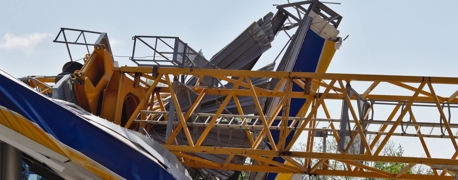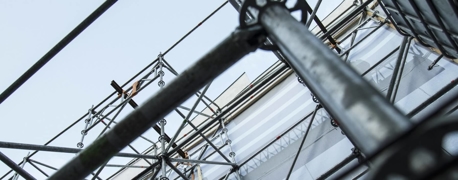Auger Accidents & Fatalities: The High Cost of Lax Safety

On January 9, 2024, a worker was cleaning out a sand spreader attached to the back of his dump truck at the end of his shift. While using a piece of wood lathe to remove residual sand, his arm was caught in the rotating auger. Alone at the time, he was pulled into the equipment and killed. The U.S. Occupational Safety and Health Administration (OSHA) cited the employer and proposed a $79,400 fine for serious safety violations (OSHA Inspection 1720762.015).
Just months later, on June 26, 2024, another tragic incident occurred when a contractor was cutting support legs from a silo in preparation for demolition. An unsecured auger—mounted roughly 60 feet above—fell, striking the worker in the head with a heavy metal flange. He died from his injuries. OSHA cited the employer, proposing penalties totaling $29,035 (OSHA Inspection 1757305.015).
According to OSHA accident records, there have been at least 140 serious auger-related accidents in the U.S. since 2020. Of these, 18 are listed as fatalities.
Whether in agriculture, construction, or industrial settings, augers are powerful devices that, if negligently operated or maintained, can turn routine tasks into life-threatening emergencies in a millisecond.
What Is an Auger?
An auger is a mechanical drilling device designed to move or bore through materials using a rotating helical screw blade, or helix blade. This spiraled blade is screw-shaped and attached to a shaft, allowing it to screw into the ground while providing support and stability.
Augers are used to drill holes, transport grain, mix feed, install utility poles, or move material in manufacturing systems. They vary in size, from hand-held post-hole diggers to massive industrial augers mounted on heavy equipment. Augers can be powered electrically, hydraulically, by internal combustion engines, or manually, depending on their size and application.
The most powerful augers can drill through solid rock, excavate holes over 100 feet deep, and move hundreds of tons of material in a single day. These machines generate thousands of pounds of torque, and their strength makes them indispensable on a variety of worksites.
Where & How Are Augers Used?
Augers are essential across a wide range of industries, each using specialized designs to perform critical tasks that involve drilling, moving, or breaking down materials. While their applications may vary, the underlying principle remains the same: a rotating helical blade that moves material.
Agriculture
Augers are used on farms, particularly for grain handling and feed mixing. Grain augers move harvested crops into silos or trucks, while feed augers help distribute or blend animal feed. Farmers also use post-hole augers for fencing and land management. These can be tractor-mounted or portable, powered by PTO (power take-off) shafts or electric motors.
Construction
In construction, augers are commonly used for earth drilling, foundation piling, and soil sampling. High-powered augers can bore deep into rock or clay to install supports for bridges, towers, or high-rise buildings. These machines are often mounted to excavators, skid steers, or truck rigs, and can drill over 100 feet deep with wide-diameter bits. The torque involved in these operations can be immense, often exceeding thousands of foot-pounds.
Utility Work
Utility companies use augers to dig holes for power poles, install underground lines, or bore through hard soil and asphalt. In urban environments, horizontal auger boring is a preferred method for creating underground passages without disturbing surface structures. This work often takes place in high-risk zones near electrical or gas lines, requiring extreme caution to avoid electrocution or explosions.
Manufacturing & Industrial Settings
In factories and processing plants, augers are used to transport and process bulk materials like grains, powders, chemicals, or food products. Auger conveyors move material through enclosed tubes, reducing spillage and exposure. In meat processing or food packaging, augers are used to mix or portion ingredients with speed and precision, but they can also be dangerous if guards are removed or lockout-tagout procedures ignored.
Mining & Oil/Gas
In the energy sector, powerful augers help drill exploratory boreholes, remove overburden, or extract core samples. These industrial augers often operate in harsh, remote conditions and are built to withstand intense mechanical stress, including drilling through bedrock or handling extreme temperatures.
From handheld tools to massive industrial machines, augers serve a vital role in shaping infrastructure, growing food, and powering entire industries. But their versatility and power are exactly what make them so dangerous when safety practices fall short.
Auger-Related Accidents & Injuries
Auger operation involves high torque, rapid rotation, and heavy materials. Even when stationary, augers can pose risks due to residual energy or improper shutdown. When active, however, the hazards increase significantly.
The following are among the most common auger-related incidents:
- Entanglement: One of the most common and devastating auger-related injuries occurs when a worker's clothing, gloves, jewelry, or limbs come into contact with a rotating blade. Augers do not stop easily once engaged, and even brief contact can result in traumatic amputations or fatalities. The January 2024 sand spreader incident is a clear and tragic example: a worker using a wood lathe to clear debris was pulled into the rotating auger and fatally injured.
- Struck-by Accidents: Augers and their components can become dislodged, collapse, or be ejected during operation or disassembly. In the June 2024 silo demolition case, an unsecured auger fell more than 60 feet, fatally striking a worker in the head. Whether due to poor rigging, structural failure, or equipment malfunction, falling auger components pose a serious struck-by hazard.
- Falls and Crush Injuries: Workers operating large augers on unstable ground, near trenches, or around unprotected holes face a high risk of falling or being crushed. Equipment tipping over, unexpected shifts in terrain, or a misstep near an active borehole can all lead to serious injury. Auger machines themselves are often large and heavy, making crush injuries particularly severe.
- Electrocution: Augers used in utility work or construction may inadvertently strike live electrical lines, especially when boring underground or working near poles. Without accurate site assessments and proper utility location procedures, workers risk electric shock, burns, or fatal electrocution.
- Trench Collapse or Suffocation: In excavation or horizontal boring operations, augers often work in tandem with trenching. When soil is unstable or not properly reinforced, a trench can collapse without warning, trapping workers inside. This can result in suffocation, crush injuries, or death, particularly when rescue is delayed.
Agricultural Auger Accidents & Confined Spaces
According to Purdue University's Agricultural Confined Space Incident Database, there were no fewer than 23 fatal and 36 non-fatal incidents involving agricultural confined spaces in 2021 alone—many involving augers.
- Between 1964 and 2013, 167 auger entanglement incidents were recorded in confined spaces. (PubMed)
- In 2023, 6 entanglement-related incidents involving augers were recorded in U.S. agriculture. (Purdue)
Given that many small farms are exempt from OSHA regulations, these numbers may be severely underreported.
Regulatory Oversight & Safety Standards
As with other heavy equipment in the workplace, employers and manufacturers must take the steps necessary to protect workers from unreasonable risks. Augers are large and powerful, but they can be operated safely if the appropriate protocols are implemented and enforced.
Several OSHA standards govern auger safety:
- Machine Guarding (29 CFR 1910.212) – Requires guards on rotating parts to prevent contact.
- Grain Handling Facilities (29 CFR 1910.272) – Regulates augers in agricultural environments to reduce entrapment and dust explosions.
- Farm Field Equipment (29 CFR 1928.57) – Mandates guarding of augers used on farms.
- General Duty Clause – Requires employers to provide a workplace free from recognized hazards.
Despite these regulations, failure to implement proper safeguards or follow procedures remains a recurring factor in many fatal incidents included in OSHA’s accident reports.
Lockout/Tagout (LOTO) Procedures for Augers
Many auger-related injuries and fatalities occur during maintenance, cleaning, or jam-clearing—precisely when machines should be fully shut down.
OSHA’s lockout/tagout (LOTO) standard (29 CFR 1910.147) is designed to prevent these incidents by requiring:
- Complete shutdown of the equipment
- Isolation from energy sources
- Locking and tagging out controls
- Verification that energy has been discharged
- Only trained, authorized personnel may perform lockout/tagout
In the January 2024 fatality, the absence of proper lockout/tagout procedures contributed directly to the worker’s death. Even if an auger appears idle, residual energy or unnoticed activation can instantly turn fatal. Lockout/tagout procedures must be non-negotiable anytime an auger is serviced or cleared.
Worker Safety Must Come First
Every auger-related injury or fatality tells the same underlying story: a breakdown in safety. Whether it’s a missing guard, a skipped lockout/tagout procedure, or a rushed task, these are preventable tragedies—not inevitable outcomes. The lives lost and families devastated are the clearest reminders that operational efficiency should never come at the cost of worker safety.
Employers, contractors, and equipment manufacturers must treat augers with the seriousness they deserve. That means enforcing training, mandating proper PPE, respecting lockout/tagout procedures, and never cutting corners with machine guarding. In the world of heavy machinery, especially augers, there is no room for second chances.


